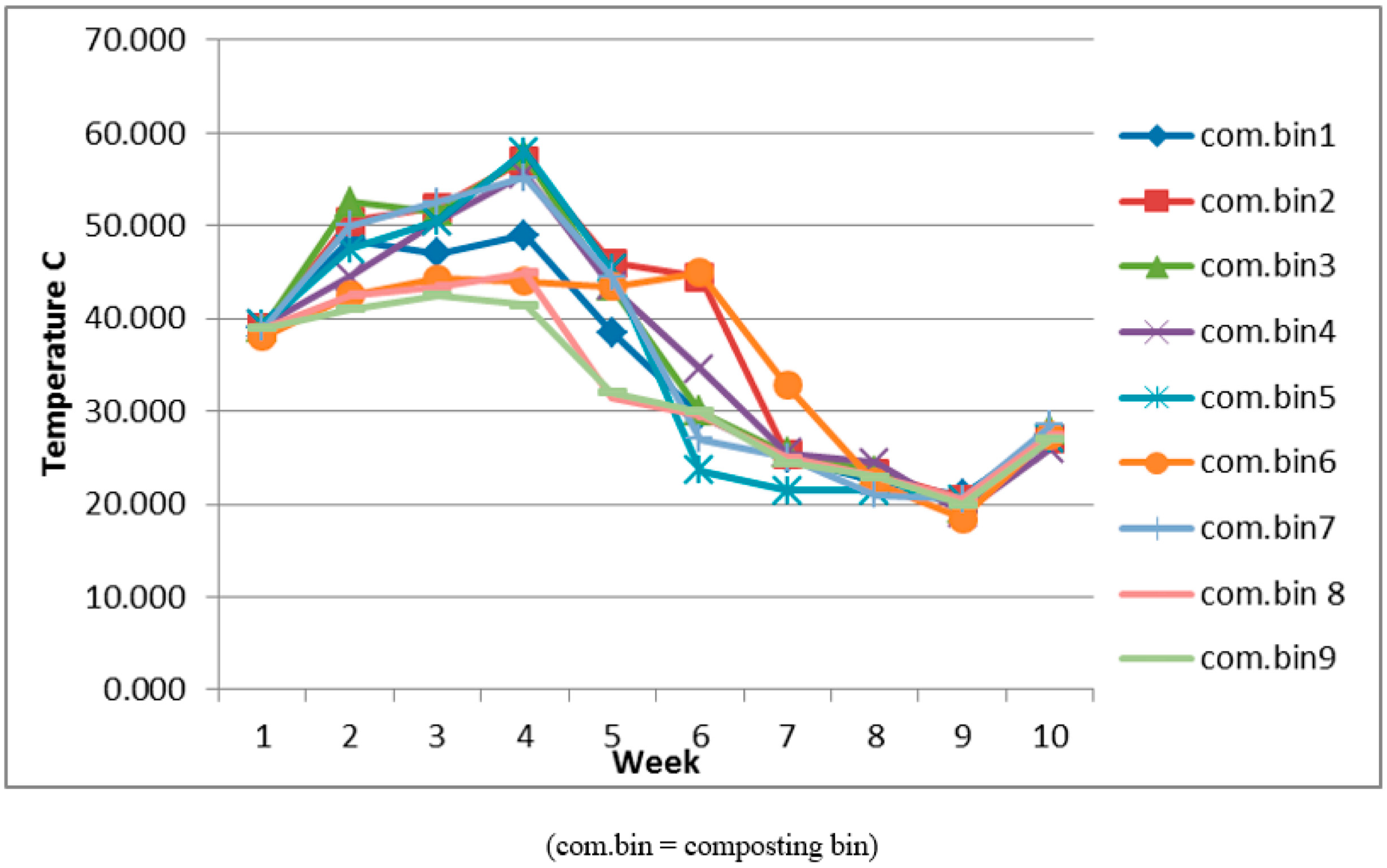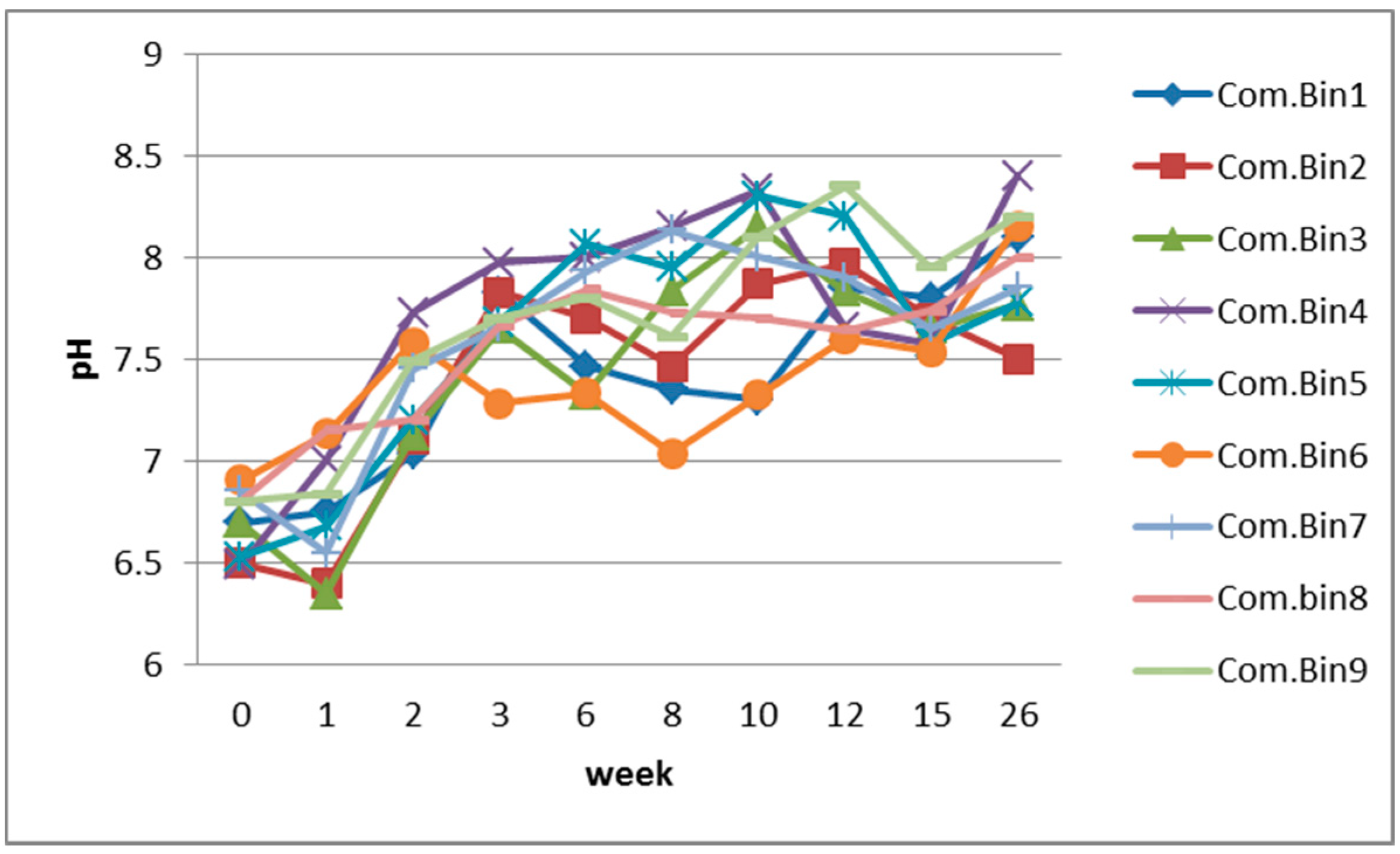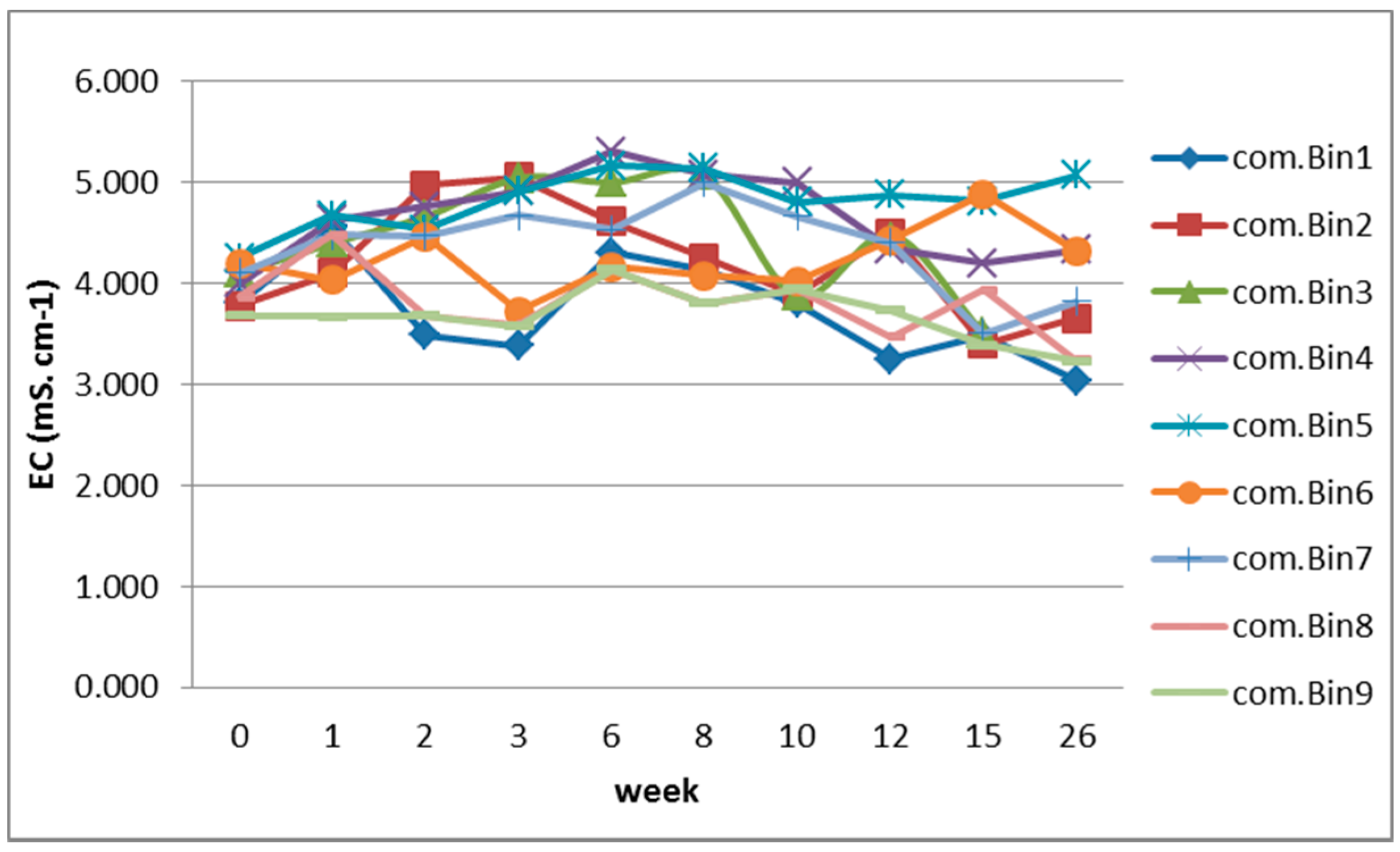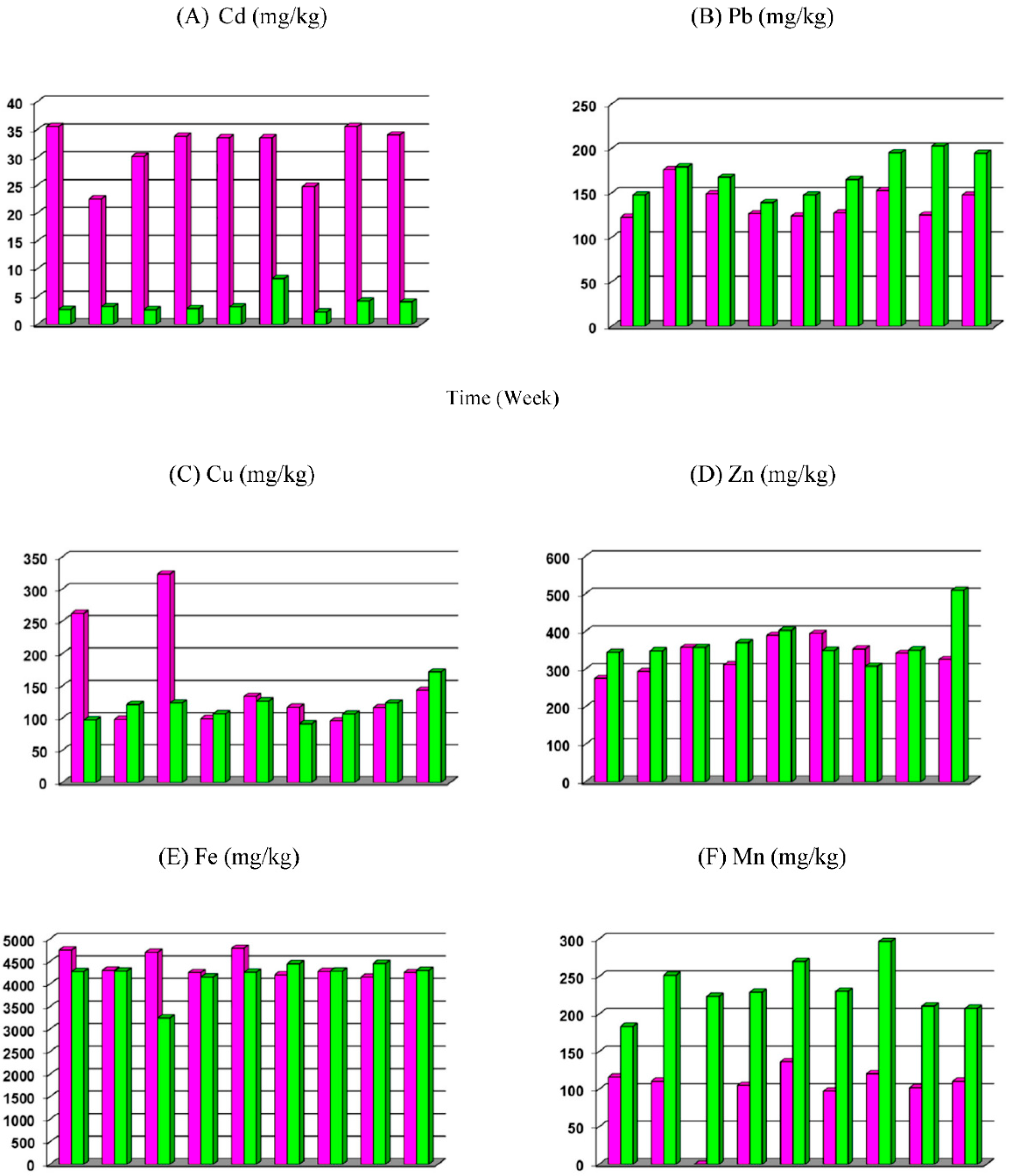Evaluation of Physio-Chemical Characteristics of Bio Fertilizer Produced from Organic Solid Waste Using Composting Bins
Abstract
1. Introduction
- To discover and choose additives for organic waste stabilization.
- To determine the viability of combining organic wastes for stabilization
- To determine the physio-chemical parameters necessary for organic waste stabilization.
- Performance evaluation of the method when coupled with various types of stabilized organic waste.
- To compare the organic matter lose percent during composting duration.
- To ascertain the presence and characteristics of heavy metals in solid waste.
2. Materials and Method
2.1. Feedstock and Composting Materials Used in the Composting Bin Methods
2.2. Design and Composting Methods
2.3. Experimental Design
2.4. Analysis of Physiochemical Characteristics
3. Results and Discussion
3.1. Chemical Composition of Organic Wastes in Composting Bins
| Raw Materials and Their Mixture Used in the Composting Bins | pH | EC (ms/cm−1) | Organic Matter (OM)% | C (%) | N (%) | C:N (%) |
|---|---|---|---|---|---|---|
| Unmixed | ||||||
| Bin 1: OSFW * (100%) | 6.70 | 3.8 | 52.69 | 29.272 | 0.99 | 29.5 |
| Mixtures | ||||||
| Bin 2: OFSW+ Animal manure (3:1) (75% + 25% by weight) | 6.47 | 4.100 | 62.182 | 34.55 | 1.18 | 29.42 |
| Bin 3: OFSW + Poultry manure (3:1) (75% + 25% by weight) | 6.73 | 4.375 | 63.56 | 35.310 | 1.435 | 24.61 |
| Bin 4: OFSW + Animal manure (2:1) (66% + 33% by weight) | 6.49 | 4.63 | 66.53 | 36.96 | 1.15 | 32.248 |
| Bin 5: OFSW + Poultry manure (2:1) (66% + 33% by weight) | 6.53 | 4.66 | 64.21 | 35.67 | 1.31 | 27.238 |
| Bin 6: OFSW + Agriculture waste (9:1) (90% + 10% by weight) | 6.90 | 4.03 | 54.193 | 30.11 | 1.05 | 28.713 |
| Bin 7: OFSW + animal + poultry manure (2:1:1) (50:25:25) (w/w) % | 6.85 | 4.47 | 68.65 | 38.14 | 1.7 | 22.433 |
| Bin 8: OFSW + Bicont (100: 2) (w/w/v) % | 6.8 | 4.475 | 49.48 | 27.49 | 1.08 | 25.457 |
| Bin 9: OFSW + Humic fulvic acid (100: 2) (w/w/v) % | 6.81 | 3.67 | 52.36 | 29.09 | 1.4 | 20.786 |
| Standard values suitable for composting Source: Standard [19,20,21] | 5.5–8.0 | - | >20 | 30–40 | >0.6 | 25–50:1 |
3.2. Physical and Chemical Characteristics
3.2.1. The Effect of Temperature
3.2.2. Effect of pH
3.3. Electrical Conductivity (EC)
3.4. Carbon:Nitrogen Ratio and Organic Matter
3.5. Effect of Nutrients (N, P and K) on the Composting Process
3.6. The Effect of Heavy Metals on Composting Characteristics
4. Conclusions
Author Contributions
Funding
Institutional Review Board Statement
Informed Consent Statement
Data Availability Statement
Conflicts of Interest
References
- Awasthi, M.K.; Pandey, A.K.; Khan, J.; Bundela, P.S.; Wong, J.W.; Selvam, A. Evaluation of thermophilic fungal consortium for organic municipal solid waste composting. Bioresour. Technol. 2014, 168, 214–221. [Google Scholar] [CrossRef] [PubMed]
- Aghbashlo, M.; Tabatabaei, M.; Soltanian, S.; Ghanavati, H. Biopower and biofertilizer production from organic municipal solid waste: An exergoenvironmental analysis. Renew. Energy 2019, 143, 64–76. [Google Scholar] [CrossRef]
- Salom, K.; Noor, T. Evaluation of waste sorting and recycling laboratory in Mahmudiya (case study). J. Econ. Adm. Sci. 2019, 25, 385–414. [Google Scholar]
- Chew, K.W.; Chia, S.R.; Yen, H.-W.; Nomanbhay, S.; Ho, Y.-C.; Show, P.L. Transformation of Biomass Waste into Sustainable Organic Fertilizers. Sustainability 2019, 11, 2266. [Google Scholar] [CrossRef]
- Zaman, A.U. A comprehensive study of the environmental and economic benefits of resource recovery from global waste management systems. J. Clean. Prod. 2016, 124, 41–50. [Google Scholar] [CrossRef]
- Foereid, B. Nutrients Recovered from Organic Residues as Fertilizers: Challenges to Management and Research Methods. World J. Agric. Soil Sci. 2019, 1, 1–7. [Google Scholar] [CrossRef]
- Bazrafshan, E.; Zarei, A.; Mostafapour, F.K.; Poormollae, N.; Mahmoodi, S.; Zazouli, M.A. Maturity and Stability Evaluation of Composted Municipal Solid Wastes. Health Scope 2016, 5, 1–9. [Google Scholar] [CrossRef]
- Khan, M.; Sharif, M. Solubility Enhancement of Phosphorus from Rock Phosphate Through Composting with Poultry Litter. Sarhad J. Agric. 2012, 28, 415–420. [Google Scholar]
- Zhao, S.; Liu, X.; Duo, L. Physical and Chemical Characterization of Municipal Solid Waste Compost in Different Particle Size Fractions. Pol. J. Environ. Stud. 2012, 21, 509–515. [Google Scholar]
- Khater, E.G. Some Physical and Chemical Properties of Compost El-Sayed. Int. J. Waste Resour. 2015, 5, 172. [Google Scholar] [CrossRef]
- Bernal, M.; Alburquerque, J.; Moral, R. Composting of animal manures and chemical criteria for compost maturity assessment. A review. Bioresour. Technol. 2009, 100, 5444–5453. [Google Scholar] [CrossRef] [PubMed]
- Bustamante, M.; Paredes, C.; Marhuenda-Egea, F.C.; Espinosa, A.P.; Bernal, M.P.; Moral, R. Co-composting of distillery wastes with animal manures: Carbon and nitrogen transformations in the evaluation of compost stability. Chemosphere 2008, 72, 551–557. [Google Scholar] [CrossRef] [PubMed]
- Storino, F.; Menéndez, S.; Muro, J.; Tejo, P.M.A.; Irigoyen, I. Effect of Feeding Regime on Composting in Bins. Compost. Sci. Util. 2017, 25, 71–81. [Google Scholar] [CrossRef]
- Li, Y.; Fang, F.; Wei, J.; Wu, X.; Cui, R.; Li, G.; Zheng, F.; Tan, D. Humic acid fertilizer improved soil properties and soil microbial diversity of continuous cropping peanut: A three-year experiment. Sci. Rep. 2019, 9, 12014. [Google Scholar] [CrossRef] [PubMed]
- Ujj, A.; Percsi, K.; Beres, A.; Aleksza, L.; Diaz, F.; Gyuricza, C.; Fogarassy, C. Analysis of quality of backyard compost and its potential utilization as a circular bio-waste source. Appl. Sci. 2021, 11, 4392. [Google Scholar] [CrossRef]
- Sharma, D.; Varma, V.S.; Yadav, K.D.; Kalamdhad, A.S. Evolution of chemical and biological characterization during agitated composting bin composting of flower waste. Int. J. Recycl. Org. Waste Agric. 2017, 6, 89–98. [Google Scholar] [CrossRef]
- Mamo, M.; Kassa, H.; Ingale, L.; Dondeyne, S. Evaluation of compost quality from municipal solid waste integrated with organic additive in Mizan–Aman town, Southwest Ethiopia. BMC Chem. 2021, 15, 43. [Google Scholar] [CrossRef]
- Bremner, J.M. Determination of nitrogen in soil by the Kjeldahl method. J. Agric. Sci. 1960, 55, 11–33. [Google Scholar] [CrossRef]
- Ahmad, R.; Jilani, G.; Arshad, M.; Zahir, Z.A.; Khalid, A. Bio-conversion of organic wastes for their recycling in agriculture: An overview of perspectives and prospects. Ann. Microbiol. 2007, 57, 471–479. [Google Scholar] [CrossRef]
- Zuccconi, F.; de Bertoldi, M. Compost specification for the production and characterization of compost from municipal solid waste. In Compost Production, Quality and the Use; Applied Science Publishing: Basel, Switzerland, 1987. [Google Scholar]
- Yousefi, J.; Younesi, H.; Ghasempoury, S.M. Co-composting of Municipal Solid Waste with Sawdust: Improving Compost Quality. Clean-Soil Air Water 2013, 41, 185–194. [Google Scholar] [CrossRef]
- Woh, C.; van Fan, Y.; Suan, L.; Idayu, I. A Review on Application of Microorganisms for Organic Waste Management. Chem. Eng. Trans. 2018, 63, 85–90. [Google Scholar] [CrossRef]
- Kosseva, M.R.; Kent, C.A. Thermophilic Aerobic Bioprocessing Technologies for Food Industry Wastes and Wastewater, 1st ed.; Elsevier Inc.: Amsterdam, The Netherlands, 2013. [Google Scholar] [CrossRef]
- Liu, H.T.; Cai, L. Effect of Sewage Sludge Addition on the Completion of Aerobic Composting of Thermally Hydrolyzed Kitchen Biogas Residue. BioResources 2014, 9, 4862–4872. [Google Scholar] [CrossRef][Green Version]
- Hemidat, S.; Jaar, M.; Nassour, A.; Nelles, M. Monitoring of Composting Process Parameters: A Case Study in Jordan. Waste Biomass Valorization 2018, 9, 2257–2274. [Google Scholar] [CrossRef]
- Olani, D.D.; Sulaiman, H.; Leta, S. Evaluation of Composting and the Quality of Compost from the Source Separated Municipal Solid Waste. J. Appl. Sci. Environ. Manag. 2012, 16, 5–10. [Google Scholar]
- Jara-Samaniego, J.; Murcia, M.D.P.; Bustamante, M.A.; Paredes, C.; Espinosa, A.P.; Gavilanes, I.; López, M.; Marhuenda-Egea, F.C.; Brito, H.; Moral, R. Development of organic fertilizers from food market waste and urban gardening by composting in Ecuador. PLoS ONE 2017, 12, e0181621. [Google Scholar] [CrossRef]
- Al-Turki, A.; El-Hadidy, Y.; Al-Romian, F. Assessment of chemical properties of locally composts produced in saudi arabia composts locally produced. Int. J. Curr. Res. 2013, 5, 3571–3578. [Google Scholar]
- Tibu, C.; Annang, T.Y.; Solomon, N.; Yirenya-Tawiah, D. Effect of the composting process on physicochemical properties and concentration of heavy metals in market waste with additive materials in the Ga West Municipality, Ghana. Int. J. Recycl. Org. Waste Agric. 2019, 8, 393–403. [Google Scholar] [CrossRef]
- Tognetti, C.; Mazzarino, M.J.; Laos, F. Improving the quality of municipal organic waste compost. Bioresour. Technol. 2007, 98, 1067–1076. [Google Scholar] [CrossRef]
- Doughtry, M. Composting for Municipalities: Planning and Design Considerations; Natural Resource, Agriculture, and Engineering Service (NRAES): College Park, MD, USA, 1998. [Google Scholar]
- Chaher, N.E.H.; Chakchouk, M.; Nassour, A.; Nelles, M.; Hamdi, M. Potential of windrow food and green waste composting in Tunisia. Environ. Sci. Pollut. Res. 2021, 28, 46540–46552. [Google Scholar] [CrossRef]
- Acatrinei-Însurățelu, O.; Buftia, G.; Lazăr, I.M.; Rusu, L. Aerobic composting of mixing sewage sludge with green waste from lawn grass. Environ. Eng. Manag. J. 2019, 18, 1789–1798. [Google Scholar] [CrossRef]
- Azim, K.; Soudi, B.; Boukhari, S.; Perissol, C.; Roussos, S.; Alami, I.T. Composting parameters and compost quality: A literature review. Org. Agric. 2017, 8, 141–158. [Google Scholar] [CrossRef]
- Bari, M.A.; Begum, M.F.; Sarker, K.K.; Rahman, M.A.; Kabir, A.H.; Alam, M.F. Mode of action of Trichoderma spp. on organic solid waste for bioconversion. Plant Environ. Dev. 2007, 1, 61–66. [Google Scholar]
- Altieri, R.; Esposito, A. Evaluation of the fertilizing effect of olive mill waste compost in short-term crops. Int. Biodeterior. Biodegrad. 2010, 64, 124–128. [Google Scholar] [CrossRef]
- Gómez-Brandón, M.; Lazcano, C.; Domínguez, J. The evaluation of stability and maturity during the composting of cattle manure. Chemosphere 2008, 70, 436–444. [Google Scholar] [CrossRef] [PubMed]
- Hussian, A.S.; Hyder, N.H.; Braesam, T.H.; Natheer, A.M. Recycling of Organic Solid Wastes of Cities to Biofertilizer Using Natural Raw Materials. J. Al-Nahrain Univ. Sci. 2016, 19, 140–155. [Google Scholar] [CrossRef]
- Hooda, P.S. Trace Elements in Soils; Wiley Online Library: Hoboken, NJ, USA, 2010. [Google Scholar] [CrossRef]
- Brinton, W.F. Compost Quality Standards & Guidelines; New York State Association of Recyclers: New York, NY, USA, 2000. [Google Scholar]
- Al-Saedi, Z.Z.; Ibrahim, J.A.K. Evaluation of Heavy Metals Content in Simulated Solid Waste Food Compost. J. Eng. 2019, 25, 62–75. [Google Scholar] [CrossRef][Green Version]





| Composting Bin | OM% Initial | OM% Mature | OM% Mean | OM Loss |
|---|---|---|---|---|
| 1 | 52.69 | 35.08 | 41.93 | 25.85 |
| 2 | 62.18 | 32.93 | 46.50 | 41.61 |
| 3 | 63.56 | 32.67 | 44.92 | 40.10 |
| 4 | 66.53 | 38.44 | 49.78 | 38.82 |
| 5 | 64.21 | 31.15 | 45.90 | 43.74 |
| 6 | 54.19 | 38.23 | 46.88 | 26.81 |
| 7 | 68.65 | 42.15 | 53.32 | 46.68 |
| 8 | 49.48 | 39.12 | 43.79 | 18.32 |
| 9 | 52.36 | 40.11 | 46.41 | 16.095 |
| Week means | 59.32 | 36.65 | LSD composting-bin * week 2.352 |
| Composting Bins | Time (Week) | N% | P% | K% |
|---|---|---|---|---|
| 1 | 0 26 | 0.990 1.50 | 0.410 1.1 | 0.565 1.300 |
| 2 | 0 26 | 1.17 1.520 | 0.325 0.695 | 0.550 1.510 |
| 3 | 0 2 | 1.435 1.31 | 0.320 0.850 | 0.565 1.550 |
| 4 | 0 26 | 1.150 2.08 | 0.575 1.390 | 0.155 1.370 |
| 5 | 0 26 | 1.310 1.170 | 0.649 0.621 | 0.610 1.220 |
| 6 | 0 26 | 0.355 1.120 | 0.355 1.200 | 0.674 0.775 |
| 7 | 0 26 | 1.700 2.050 | 0.642 0.860 | 1.190 1.570 |
| 8 | 0 26 | 1.080 1.330 | 0.335 0.520 | 0.545 0.705 |
| 9 | 0 26 | 1.400 1.230 | 0.624 0.335 | 0.800 0.900 |
| LSD composting bin | 0.024 | 0.025 | 0.018 | |
Publisher’s Note: MDPI stays neutral with regard to jurisdictional claims in published maps and institutional affiliations. |
© 2022 by the authors. Licensee MDPI, Basel, Switzerland. This article is an open access article distributed under the terms and conditions of the Creative Commons Attribution (CC BY) license (https://creativecommons.org/licenses/by/4.0/).
Share and Cite
Ajaweed, A.N.; Hassan, F.M.; Hyder, N.H. Evaluation of Physio-Chemical Characteristics of Bio Fertilizer Produced from Organic Solid Waste Using Composting Bins. Sustainability 2022, 14, 4738. https://doi.org/10.3390/su14084738
Ajaweed AN, Hassan FM, Hyder NH. Evaluation of Physio-Chemical Characteristics of Bio Fertilizer Produced from Organic Solid Waste Using Composting Bins. Sustainability. 2022; 14(8):4738. https://doi.org/10.3390/su14084738
Chicago/Turabian StyleAjaweed, Aseel Najeeb, Fikrat M. Hassan, and Nadhem H. Hyder. 2022. "Evaluation of Physio-Chemical Characteristics of Bio Fertilizer Produced from Organic Solid Waste Using Composting Bins" Sustainability 14, no. 8: 4738. https://doi.org/10.3390/su14084738
APA StyleAjaweed, A. N., Hassan, F. M., & Hyder, N. H. (2022). Evaluation of Physio-Chemical Characteristics of Bio Fertilizer Produced from Organic Solid Waste Using Composting Bins. Sustainability, 14(8), 4738. https://doi.org/10.3390/su14084738







